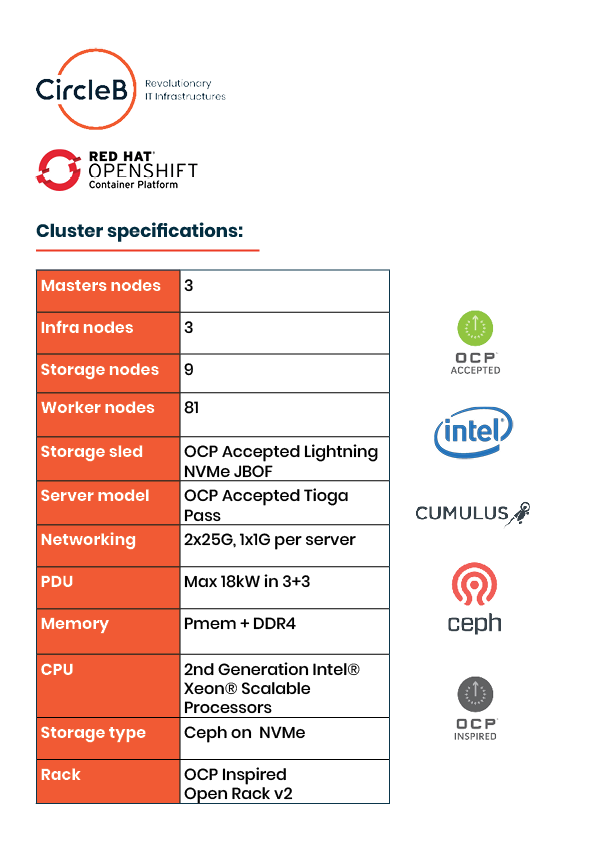Red Hat OpenShift Container Platform
Our integrated solution for the Red Hat OpenShift Container Platform is a step forward to software modernization. The solution features implementations that run highly available and scalable microservices, such as web servers, databases, java applications, etc.
What does this integrated solution offer?
- OpenShift Container Platform offers accelerated application development and delivery with minimal configuration and management overhead supported by the latest hardware technologies like Intel® Xeon® Scalable Processors, NVMe storage, persistent memory and 25G ethernet.
- Out of the box security from the operating system layer up to the container registries.
- Additionally, the latest version of RedHat OpenShift has the option to boot the platform with FIPS (Federal Information Processing Standard) compliant encryption for handling extremely sensitive data and workloads.
- Simple and highly automated installation and over-the-air updates utilized by Kubernetes operators.
- The possibility of horizontal scaling by adding new racks to spread and increase workloads. Furthermore, the powerful hardware running the master nodes enables extending the cluster to around 1000 nodes without changing the control plane.
- The latest NVMe storage is tested to comply with the needs of etcd, providing high endurance and low write latency.
- Reliability and redundancy is achieved in both control level and data level.
- OpenShift 4 is based on Ceph and Nooba storage which offers object, block and file capabilities. Combined with the high IOPS and microsecond grade latency offered by the latest NVMe storage units, it guarantees ultra-high performance.
Example of worker nodes planning according to application requirements
| Pod Type | Pod Quantity | Max Memory (Per Pod) | CPU Cores (Per Pod) | Persistent Storage (Per Pod) |
| apache | 500 | 500 MB | 0.5 | 1 GB |
| node.js | 300 | 1 GB | 1 | 1 GB |
| postgresql | 200 | 1 GB | 2 | 10 GB |
| JBoss EAP | 200 | 1 GB | 1 | 1 GB |
Extrapolated Requirements: 1150 CPU cores, 950GB RAM, and 3TB storage
|
Nodes Quantity |
CPU |
RAM (GB) |
Storage |
|
20 |
80 |
128 |
7 TB |
In this example, the environment would be roughly 30 percent overcommitted.
Applying the example on our provided environment
| Nodes Quantity | Total CPUs | RAM (GB) | Storage |
| 81 | 6480 | 10 TB | 21 TB |
If the same application mentioned in the example would be run on the cluster, the amount of pods possible to run with the available resources is the following:
| Pod Type | Pod Quantity |
| apache | 2500 |
| node.js | 1500 |
| postgresql | 1000 |
| JBoss EAP | 1000 |
For a different type of workload, further calculations can be done. Yet, it is good to know that one worker node is tested to run a maximum of 250 pods. With 81 worker nodes the cluster can generally run a total of 20,250 pods.
Product Information
- Model #: Red Hat OpenShift Container Platform
OCP Recognized Products
- Wiwynn Tioga Pass Standard SV7220G3-S (2U OCP server) - up to 768GB; 8GB/16GB/32GB DDR4 up to 2666MT/s; 12 DIMM slots.
- M.2 FPGA Card
- Wiwynn Lightning NVMe JBOF up to 30 NVMe SSDs
Networking Software

Storage Software





